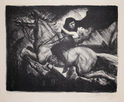
19th, 20th & 21st Century Fine Prints
707-546-7352 · fax 707-546-7924 · web: www.annexgalleries.com · email: artannex@aol.com
Albert Edward Sterner Biography
Albert Edward Sterner
American
1863–1946
Biography
Albert Edward Sterner was a painter, etcher, engraver, lithographer, and illustrator, and was also sought after as a portraitist. He worked both in America and abroad and exhibited paintings throughout his career, but he gained particular recognition as an illustrator, providing images for, among other books, George William Curtis’s Prue and I, François Coppée’s Ten Tales, the ten-volume Stedman/Woodbury edition of the works of Edgar Allan Poe (1894-95), and Mrs. Humphrey [Mary Augusta] Ward’s Eleanor (1900), The Marriage of William Ashe (1905), and Fenwicks' Career (1906).
Sterner was born in London in March 1863 to an American father and an English mother, who named her son after the Prince of Wales, later King Edward VII. His family moved to Brussels for eleven years and then returned to England and settled in Birmingham, where Sterner was enrolled at King Edward’s School. Because of his aptitude for drawing, in 1875 he was also sent to take art classes at the Birmingham Art Institute. When his family moved to Chicago, Sterner began working in 1879 for a number of lithography and engraving companies as well as for the theatre scene painter, Walter Burridge. He also produced his first illustrations for the stories of Harry B. Smith published in the weekly serial, the Rambler. (1)
In 1883, Sterner moved to New York City where he did illustrations for Life, Harper’s, Scribener's, Collier's, and Century magazines. However, realizing that he needed more technical training, he left for Paris and enrolled at the Académie Julien in Paris where he studied under Gustave Boulanger and Jules-Joseph Lefebvre and at the École des Beaux-Arts under Jean-Léon Gérôme. Sterner moved back to New York City in 1885 and opened a studio, though he would frequently return to Paris throughout his life and in 1891 his painting, "Le Célibataire", was accepted in the Paris Salon, where it received an honorable mention. His first public exhibition was at Keppel’s Gallery in New York, where he showed paintings, watercolors, and the series of drawings for Prue and I.
Albert Sterner’s art won medals at the Paris Exposition of 1900, the Buffalo Pan-American Exposition in 1901, and the Munich Internationale Ausstellung of 1905, where he received a gold medal. About 1900 Sterner turned to portraiture, creating a signature style with his “sanguines,” red-chalk portrait drawings, often augmented with graphite. In 1911, writing in the New York Tribune, the critic Royal Cortissoz said of Sterner’s chalk portraits: “What is the secret of the charm which exhales from his drawings? It is at bottom, no doubt, his taste, his feeling for beauty of form, his whole artistic mastery over the medium. Nay, it is more than the medium. He has studied the living model, he has given thought to matters of composition, he has seriously interested himself in light and shade, and always…he has taken care to draw like a gentleman.” He would later write, in 1915: “[Sterner] carries conviction because he paints a portrait from within, sees it as a form of art, and does his work with a conscience.”
In 1915, Albert Sterner and several notable artists, including Childe Hassam and George Bellows, founded the Painter-Gravers of America, an organization which hoped to improve the general quality of American prints and “further the understanding and appreciation in the United States of the methods used by artists for autographic reproductions of their work in engraving, lithography, and etching, and to give exhibitions of such work and to provide for sales.” Similarly, in 1919, the year he became an Associate Member of the National Academy, Sterner also became a charter member of the New Society, forty painters who broke away from the precepts of the Academies and their pedagogical restrictions as to style and medium. Beginning in 1918 he taught at the Art Students League in New York. In 1941 he was awarded the Carnegie Prize from the National Academy of Design, and the Corcoran Gallery of Washington, D.C., exhibited his work eight times at its biennials between 1907 and 1943.
Sterner died in Astoria, New York on December 16, 1946.
Information partially sourced from the Dumbarton Oaks Museum in Washington, D.C.



